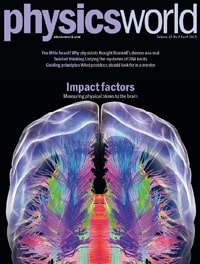
By Matin Durrani
If you’re a member of the Institute of Physics, the April 2013 issue of Physics World is now ready to view online or through our apps.
This month marks the 60th anniversary of the discovery of the structure of DNA by James Watson and Francis Crick and – to celebrate that milestone – we have a great feature on an unusual aspect of the famous double helix: namely, how knot theory can help us to understand how and why DNA tangles up.
Elsewhere in the issue, we continue the biophysics theme by looking at the damage caused to the human brain by blows from sports injuries or by the shock waves from exploding bombs. This is not traditional physics territory by any means, but surely there is no harm in physicists bringing a fresh perspective to such matters?
Our final feature this month looks at the history of Maxwell’s demon – the tiny being originally devised by James Clerk Maxwell as a thought experiment to evade the second law of thermodynamics. But, as Philip Ball explains, some of the physicist’s contemporaries actually believed it was an intelligent being that could bridge hidden worlds and provide a scientific route to immortality of the human soul.
Enjoy the issue – and do let us know what you think by e-mailing pwld@iop.org.
Members of the Institute of Physics can access the entire new issue free through the digital version of the magazine or by downloading the Physics World app onto your iPhone or iPad or Android device, available from the App Store and Google Play, respectively.
For the record, here’s a rundown of highlights of the issue:
• Physicist chosen for top energy role – US President Barack Obama has nominated Ernest Moniz as energy secretary, but he will face a tough time given a budget squeeze and the need to tackle climate change, as Peter Gwynne reports
• Designing the future – Joe Paradiso has gone from high-energy physics researcher to working on futuristic media technologies. James Dacey talks to him about working at the MIT Media Lab
• Defining physics – Peter Main and Charles Tracy argue that physics can be better defined – and taught in schools – as a way of thinking and as an approach to understanding
• Measuring culture – Now that physicists are on the verge of perfecting their system for measuring objects, what is preventing them – asks Robert P Crease – from measuring values too?
• Physics where it hurts – Impacts from bomb blasts and in contact sports can cause incurable mental problems for soldiers and athletes, with changes in the brain similar to those seen from Alzheimer’s disease. Sidney Perkowitz explores the physical analysis that is forming a critical part of the scientific and clinical attack on this insidious disease
• The knotted strands of life – Six decades after the discovery of DNA’s double-helix structure, the molecules that make up the genetic code are still revealing some fascinating twists. Davide Marenduzzo, Cristian Micheletti and Enzo Orlandini explore the physics of DNA knots
• A demon-haunted theory – James Clerk Maxwell originally devised his demon as a thought experiment to evade the second law of thermodynamics. But, as Philip Ball explains, some of the physicist’s contemporaries actually believed it was an intelligent being that could bridge hidden worlds and provide a scientific route to immortality of the human soul
• Life among the MERTians – Stephen J Pyne reviews Working on Mars: Voyages of Scientific Discovery with the Mars Exploration Rovers by William J Clancey
• Beyond the executive summary – Gail H Marcus reviews Energy for Future Presidents: the Science Behind the Headlines by Richard A Muller
• The good mentorship guide – Sarah Bohndiek describes some of the key traits postdocs should look for in a potential mentor and offers advice on selecting the right mentor
• The long chase – In this month’s Lateral Thoughts column, Philip Dixon imagines being the quarry of one the biggest hunts in physics
If you’re not yet a member, you can join the Institute as an IOPimember for just £15, €20 or $25 a year. Being an IOPimember gives you a full year’s access to Physics World both online and through the apps.



